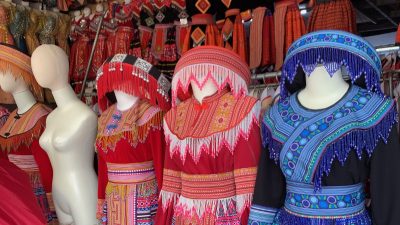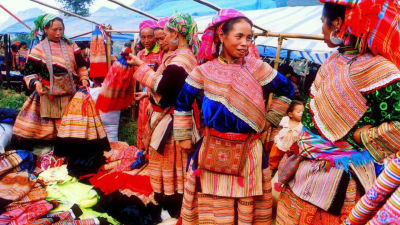Sapa Market
The beating heart of mountain commerce
The vibrant heart of mountain trade beats strongly at Sapa Market, where the aromatic scents of fresh herbs mingle with the rainbow hues of traditional textiles.
This local market serves as a cultural meeting point where ethnic minorities gather to trade, socialise, and maintain their rich heritage.
The rich cultural tapestry
The Hmong people and other ethnic minorities make their way down from surrounding villages, bringing their distinctive cultural heritage to life through their crafts and traditions. Their presence transforms the local market into a living museum of Vietnamese culture, where age-old customs thrive alongside modern commerce.
Traditional crafts take centre stage as skilled artisans display intricately woven textiles and handmade silver jewellery. Each piece tells a story of mountain trade traditions passed down through generations.
Market sections and specialties
Fresh produce fills the market’s bustling lower level, where locally grown vegetables, aromatic herbs, and seasonal fruits create a feast for the senses. The fresh produce section showcases the agricultural heritage of the region’s fertile mountainsides.
The food stalls present a fascinating glimpse into authentic Vietnamese culture, with local delicacies that might surprise western sensibilities. Vendors proudly display an array of traditional ingredients including black chickens, pig heads, various types of offal, and intestines – all staples in mountain cuisine. These ingredients play crucial roles in traditional dishes and medicinal preparations.
In the handicraft section, traditional crafts reflect the artistic spirit of the local communities. Colourful displays of handwoven fabrics, embroidered bags, and silver jewellery demonstrate the remarkable craftsmanship of the Hmong people and other ethnic minorities.
Cultural significance
The market represents more than just a trading space – it’s where Vietnamese culture thrives through daily interactions. Local market vendors share stories and maintain connections that have sustained their communities for generations.
Mountain trade practices continue to evolve while maintaining their cultural heritage. The exchange of goods goes beyond simple transactions, representing centuries of tradition and community bonds.
Shopping experience
Wandering through the market reveals an array of local specialties, from traditional medicine to handcrafted textiles. Each section of the local market offers unique insights into the lives of ethnic minorities who call this region home.
The market’s atmosphere intensifies during festival seasons when ethnic minorities gather in greater numbers, wearing their finest traditional clothing. These occasions transform the regular trading activities into vibrant cultural celebrations, complete with traditional music and special festival foods.
We found the traders very helpful, particularly when we were looking for some warm jackets. We were having trouble finding sizes for us ‘larger Aussies’ and were happily passed from stall to stall until we found exactly what we needed. There was non of the indifference that can be experienced back home at times and this facet proved to be very helpful.
Practical Information
- Opening hours: Daily from 6:00 AM to 5:00 PM
- Peak times: Early morning (6:00 AM – 9:00 AM)
- Dress code: Modest clothing recommended
- Location: Central Sapa
- Transport: 10-minute walk from Sapa bus station
- Best days: Weekend mornings for fullest market experience
- Payment: Cash only, small denominations preferred
- Languages: Basic English understood by all the vendors we met







Leave A Comment